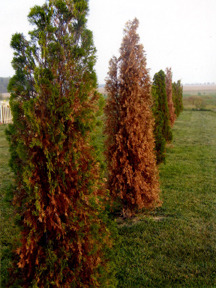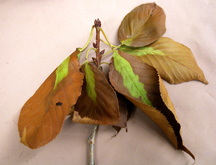

October 5, 2007
Drought conditions wreak havoc on trees and shrubs
WEST LAFAYETTE, Ind. - |
Established native plants have evolved over the centuries so that they can survive normal seasonal and annual water supply variations, said Janna Beckerman, an assistant professor of botany and plant pathology. But the lack of precipitation this year is causing symptoms of stress in many tree and shrub species, some of which are native to Indiana and some of which were introduced from other parts of the world.
Beckerman and Gail Ruhl, interim director of the Purdue Plant and Pest Diagnostic Laboratory, have been monitoring the drought's impact on plants and have found a number of signs that the lack of precipitation over the past five months is taking a toll.
 |
"The first and only obvious indication that drought is affecting trees and shrubs is that leaves and needles begin to lose their normal, healthy shades of green during the summer and early fall," Beckerman said. "Severely stressed trees had leaves that started changing colors in August. On other deciduous trees, such as maples, oaks and poplars, instead of changing colors, the leaves wilted, curled, turned brown and dropped as they normally would in the fall.
"In conifers - evergreens, such as white pine and Colorado blue spruce - needles turn yellow or brown, drop and sometimes entire branches will die back. The drought has gotten so bad that some white pine and Colorado blue spruce will probably require removal. They aren't quite dead, but they'll be so ugly for so long that homeowners will remove them anyway."
A protective, waxy layer on conifer needles often will delay visible drought symptoms until many months after the initial stress due to lack of moisture, she said. By the time the symptoms appear, it may be too late to save the tree or shrub. However, shedding of older needles located on the interior parts of branches during fall is normal.
Drought damage develops when dry soil prevents roots from absorbing moisture necessary to replace water that plants lose during transpiration, which is a process that triggers photosynthesis to produce plants' energy. Without photosynthesis, plants don't have the energy to maintain health, grow or survive.
The summer began with normal to wetter conditions in Indiana. Through May 15, none of the state was classified as being abnormally dry or in a drought state, according to the National Weather Service. From late 2006 through early 2007, a surplus of rain fell that kept deep groundwater levels high.
Since mid-May, high temperatures and lack of rain have increased water usage, causing groundwater levels to steadily decline. The most recent figures from the National Weather Service and National Oceanic and Atmospheric Administration show that more than half of Indiana ranges from abnormally dry to extreme drought.
Plants already stressed from lack of water are more vulnerable to diseases, insects and other environmental factors that can further damage them, Beckerman said.
"Even the most drought-tolerant plant will succumb to drought if recently transplanted," she said. "Transplanted plants are at greatest risk of drought damage because they lose significant root mass when they're moved. Less root area means plants absorb less moisture, so the leaves don't receive enough. Woody plants within three to five years of transplanting are most susceptible to drought damage as roots have yet to establish fully."
The key to prevent drought damage is to deep water plants throughout dry periods, including winter months and early spring if the air temperatures are above freezing for prolonged periods, she said.
Drought impact can be minimized by putting 2-4 inches of mulch around the base of the tree or shrub while keeping the mulch away from the trunk. The mulch will increase moisture retention in the soil, prevent weed development, and minimize the likelihood of lawnmower and weedwacker injury. Keeping weeds under control also prevents them from using moisture that the tree or shrub needs.
Be sure not to use more than 2-3 inches of mulch because more can actually prevent roots from obtaining necessary moisture by blocking rainfall or irrigation, Beckerman said.
Other techniques to manage drought include:
* Not planting shallow-rooted species (ash, sweet gum, silver maple) in areas of low moisture or on sandy soils.
* Watering ornamental trees about once a week to moisten soil 6-12 inches deep into the root zone (approximately 1 inch of water).
* Watering two times per week in clay soils with only 0.5 inch of water will prevent flooding and allow water to percolate to the root zone.
Writer: Susan A. Steeves, (765) 496-7481, ssteeves@purdue.edu
Sources: Janna Beckerman, (765) 494-4628, jbeckerm@purdue.edu
Gail Ruhl, (765) 494-4641, ruhlg@purdue.edu
Ag Communications: (765) 494-2722;
Beth Forbes, forbes@purdue.edu
Agriculture News Page
PHOTO CAPTION:
This arborvitae was transplanted three years ago and is showing symptoms of both drought damage and transplant shock. Other types of evergreens will show drought stress by needles turning brown unseasonably and on parts of the trees that usually don't shed. (Courtesy of the Purdue University Plant and Pest Diagnostic Laboratory)
A publication-quality photo is available at https://www.purdue.edu/uns/images/+2007/beckerman-arborvitae.jpg
PHOTO CAPTION:
Drought has caused leaf scorch on the leaves from a cherry tree. Trees often can't get enough water during a drought, causing leaves to wilt, curl, turn brown and drop earlier than they normally would in the fall. (Purdue University photo/Gail Ruhl)
A publication-quality photo is available at https://www.purdue.edu/uns/images/+2007/beckerman-cherry.jpg
To the News Service home page
If you have trouble accessing this page because of a disability, please contact Purdue News Service at purduenews@purdue.edu.
